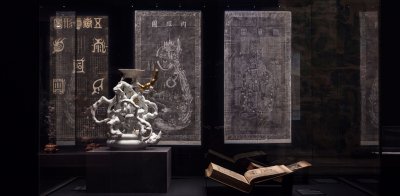Alchemy. The Great Art
Today until July 23rd the Berlin’s Kulturforum hosts this large-scale exhibition
June 21st, 2017Today starts, until July 23rd, this large-scale exhibition at Berlin’s Kulturforum illuminates the deep relationship between Art and Alchemy on an exhibition space of 800 square meters. More than 200 works representing over 3,000 years of art and cultural history from the collections of the Staatliche Museen zu Berlin and the Staatsbibliothek zu Berlin will be on display, supplemented by outstanding loans from renowned international institutions.
Alchemy is a creation myth and therefore intimately related to artistic practice – this idea permeates all eras and cultures, shaping Alchemy’s theoretical underpinnings as well as artistic creativity. An exhibition dedicated to the art of Alchemy is consequently predestined for the Staatliche Museen zu Berlin, whose diverse collections stretch over time from pre- and early history to the present.
Alchemy is a universal theme for a universal museum.The term ‘Alchemy’ is derived from the Arabic al kīmiyá (‘metal-pouring’, i.e. smelting or alloying) and has been disseminated across the Western world since the twelfth century through the translation of Arabic texts. Handicraft related to Alchemy, however, existed long before the human historical record.
Blacksmithing and metallurgy in the Babylonian Empire, the imitation of precious metals and gemstones in what was known as the ‘temple industry’ and the dyers’ trade in Ancient Egypt, the Greek natural philosophers’ material conversion processes, and Chinese and Indian pharmaceutical practices and immortality myths can serve as early protoalchemical evidence.
In medieval Europe, Alchemy was known as Ars magna (the Great Art), and its practice produced artistic effects. The idea that Alchemy is the art that most closely imitates nature was debated at the universities in Paris and Oxford by scholars like Thomas Aquinas and Roger Bacon.
Contrary to the popular misconception that the aim of alchemists was primarily chrysopoeia (the making of gold), there were numerous adepts who strove for nothing less than the imitation of the divine act of creation itself, a goal that spurred them on to attempt not only to imitate nature, but ultimately even to surpass it.
This drive to transmute naturally-existing matter into a man-made concoction still influences artists today, especially contemporary artists who understand the processual transformation of material as an integral part of their work.
Beginning in the late Middle Ages, art created its own visual language that continues to shape our perception of Alchemy even today. Mythical creatures from the animal kingdom, two-headed hermaphrodites, homunculi in glass vials, and godlike alchemist-creators at work crafting an artificial world based on their imagination are the protagonists of magnificent illuminated manuscripts and alchemical tracts from this period.
These images have even filtered down into our contemporary daily lives. The mythology of alchemy is used effectively in scenes in Frankenstein, in adaptations of Goethe’s Faust, in the appraised American television series Breaking Bad, and in the manga Fullmetal Alchemist.
Curated by Jörg Völlnagel, the exhibition Alchemy. The Great Art is divided into three sections which trace these different manifestations in artistic and handicraft practice and visual culture from antiquity to the present: CREATION is dedicated to the origins of Alchemy, and shows the influence of alchemical technologies on artistic practice. CREATOR centres the alchemists themselves, presenting them at work and illustrating their creations both allegorically and practically. And CREATURE focuses on the products of themagnum opus, or Great Work – the successful conversion of a base substance into gold, and the spiritual transformation of the adepts, which can be seen in the image of the homunculus, the philosopher’s stone, or as visualizations of the process that leads to an all-transforming transmutation.
It becomes clear that Alchemy remains to this day far more than a fantastic pipe dream of making gold: Alchemy is a creation myth and therefore intimately related to artistic practice.
On display are paintings and miniatures, drawings and prints, scrolls, manuscripts and laboratory books, photographs and cyanotypes, chemograms and scanographies, sculptures, installations and videos, fake gems and artificial gold, stoneware and porcelain, gold-ruby glass and jewellery.
Works of modern and contemporary art include those by Carl Andre, Joseph Beuys, Fischli/Weiss, Heinz Hajek-Halke, Anselm Kiefer, Yves Klein, Jeff Koons, Alicja Kwade, Bernhard Prinz, Sarah Schönfeld, Gerda Schütte, Harry Smith, Natascha Sonnenschein, Rudolf Steiner, and Maria Volokhova.
As a prologue to the exhibition and on the occasion of the 67th Berlinale, US-American artist Joe Ramirez presents the world premiere of The Gold Projections from 7 to 19 February 2017. The material and filmic quintessence of the two-week performance will be included in the Alchemy exhibition.
References:
- https://www.visitberlin.de/en/event/alchemy-great-art https://www.visitberlin.de/en/event/alchemy-great-art
- http://www.smb.museum/en/exhibitions/detail/alchemie-die-grosse-kunst.html http://www.smb.museum/en/exhibitions/detail/alchemie-die-grosse-kunst.html


